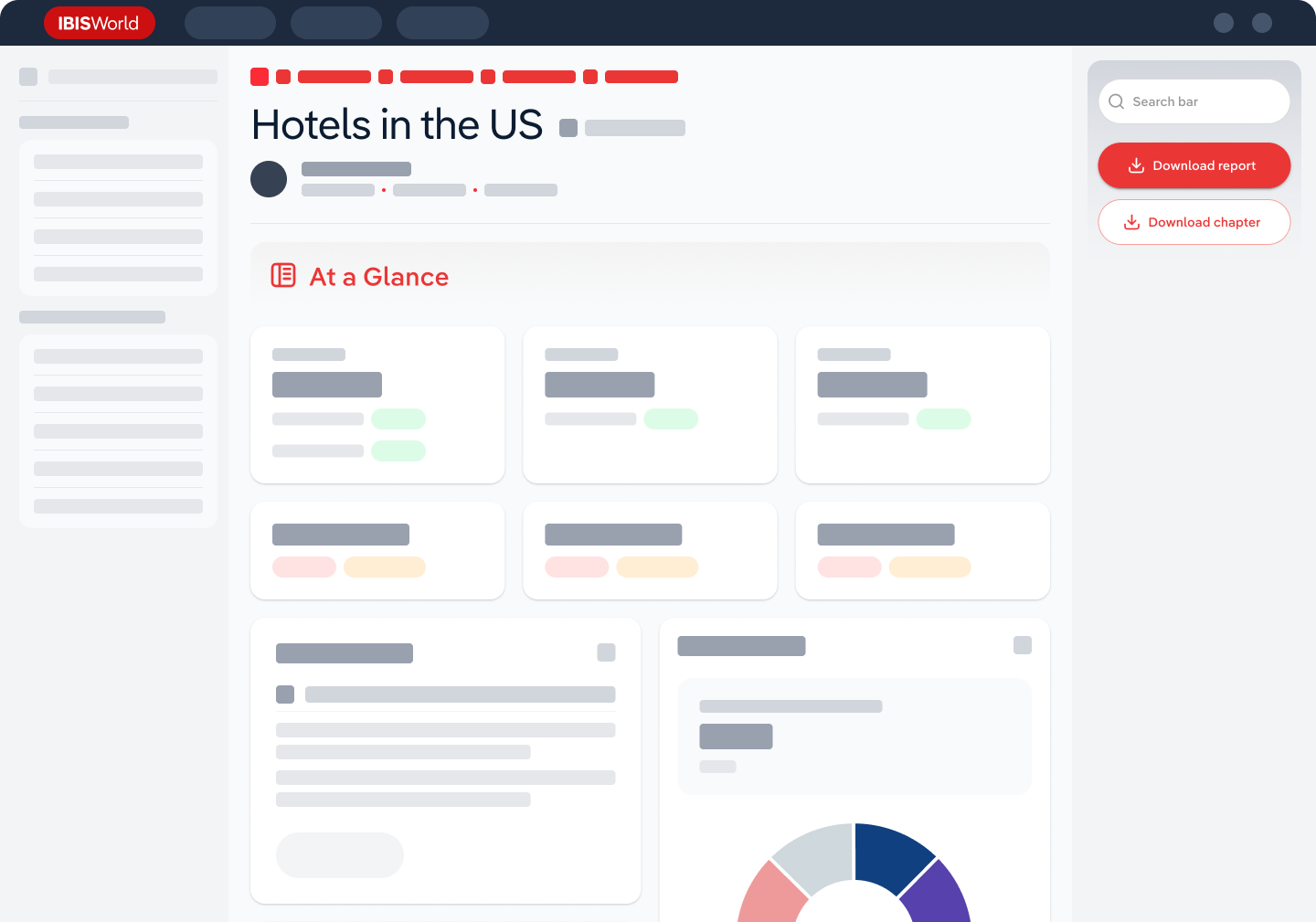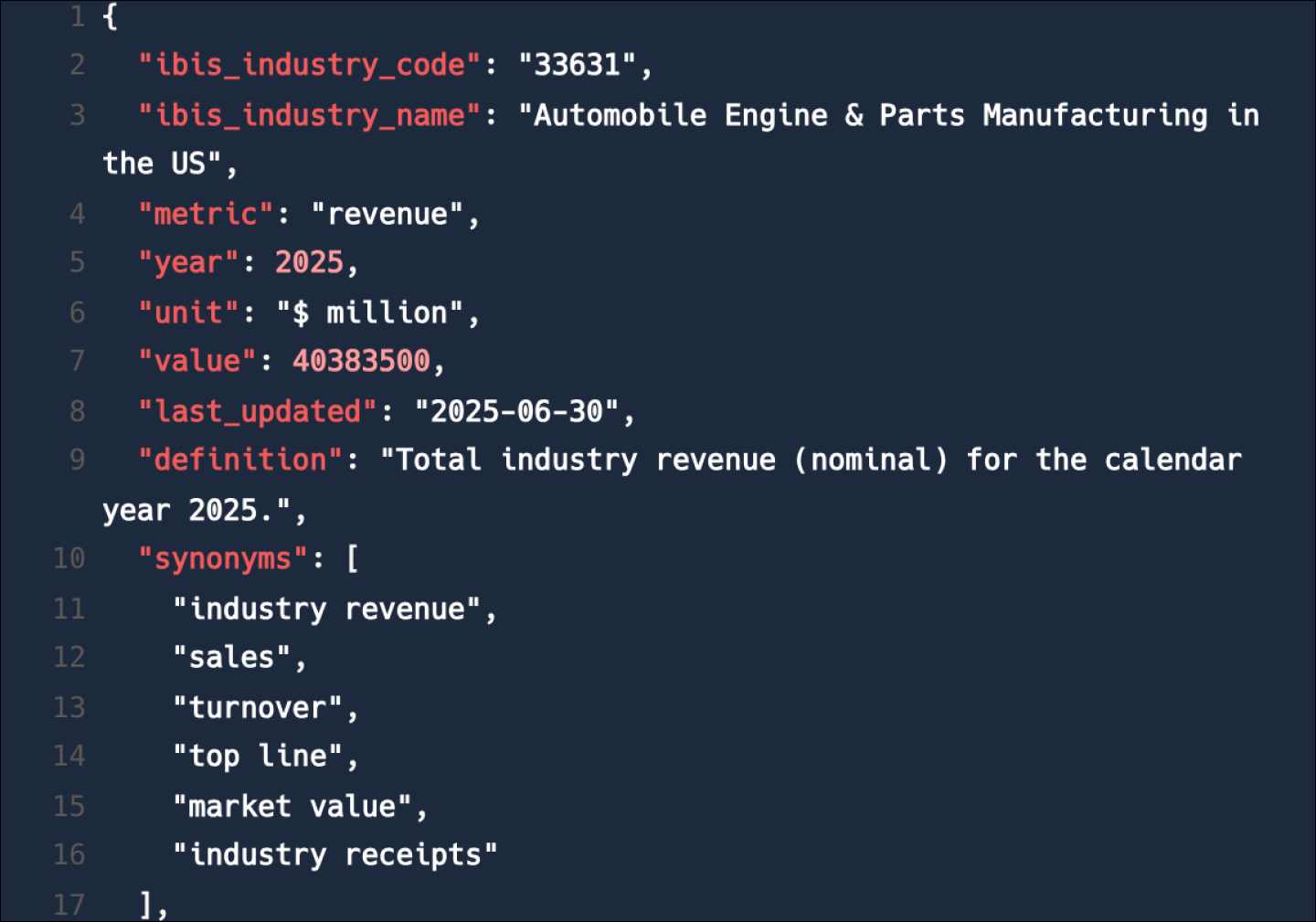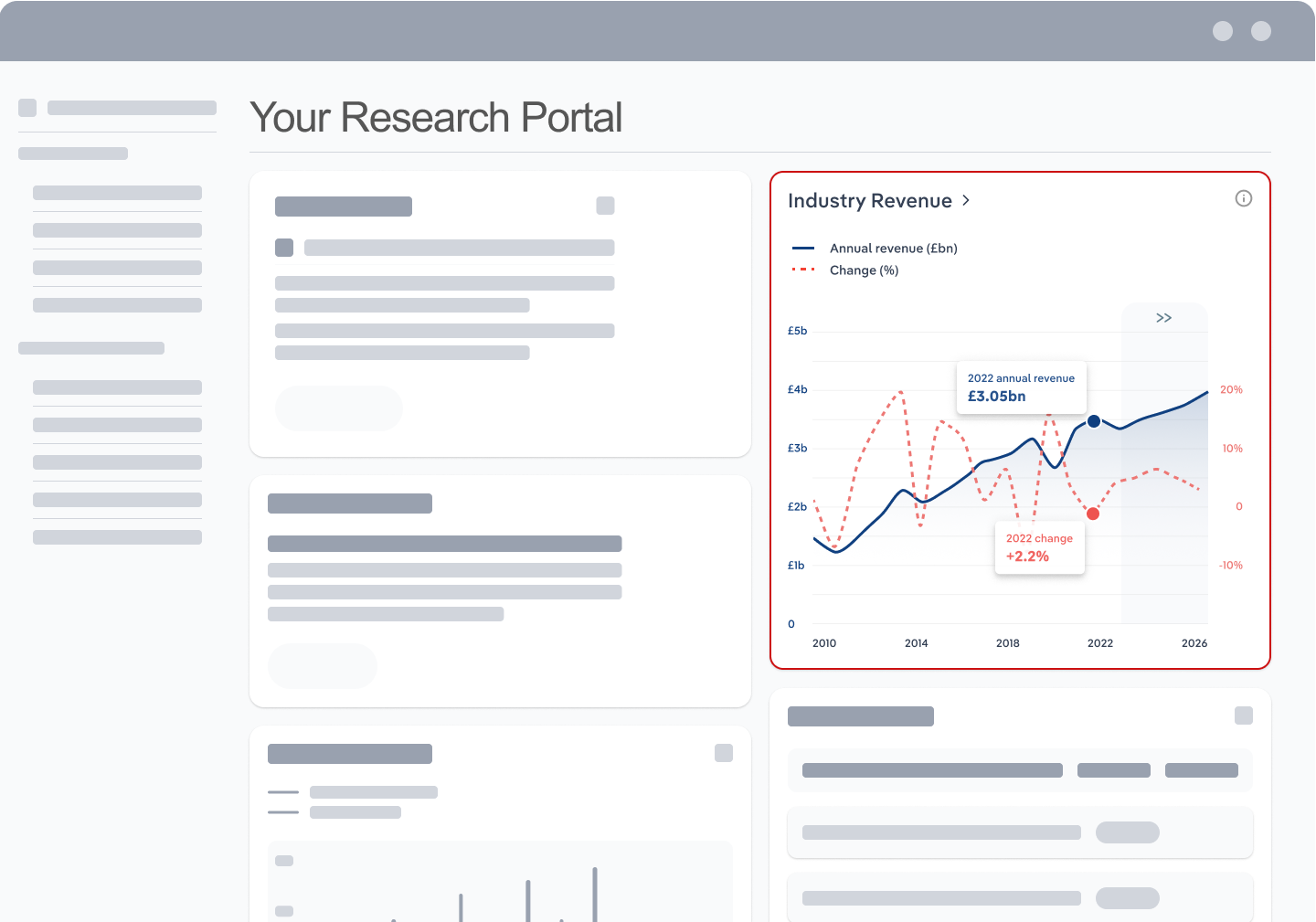Industry Statistics and Trends
Market size and recent performance (2015-2030)
Industry revenue has grown at a CAGR of 2.8 % over the past five years, to reach an estimated $2.4bn in 2025.
Trends and Insights
Weak demand from new construction is partly offset by robust demand from the repair market
- The industry has encountered difficulties due to a slowdown in residential construction. Although residential construction experienced strong growth early in the period, the housing market was impacted by rising mortgage rates later on, which remain at historically high 7.0% as of the first half of January 2025. Despite strong housing demand, supply is constrained by factors like zoning laws and labor shortages in construction, which negatively impacts demand for roofing products.
- Additional trends and insights available with purchase
Industry outlook (2025-2030)
Market size is projected to grow over the next five years.
Trends and Insights
Residential construction is expected to grow, resulting in increased demand for roofing products
- Residential construction, a key driver in the industry, is anticipated to expand during the forecast period. This growth is based on expectations of falling mortgage rates, sustained population increases and overall economic advancement. These factors create a favorable environment for residential development, enhancing opportunities for businesses within roofing manufacturing and related industries.
Biggest companies in the Sheet-Metal Roofing Manufacturing in the US
| Company | Market Share (%)
2025 | Revenue ($m)
2025 | Profit ($m)
2025 | Profit Margin (%)
2025 |
|---|---|---|---|---|
Cornerstone Building Brands, Inc. | 311.6 | 15.6 | 5.0 |
To view the market share and analysis for all 1 top companies in this industry, view purchase options.
Products & Services Segmentation
Industry revenue is measured across several distinct product and services lines, including Galvanized steel roofing, Mixed-metal steel roofing and Aluminum roofing. Galvanized steel roofing is the largest segment of the Sheet-Metal Roofing Manufacturing in the US.
Trends and Insights
The strength and affordability of galvanized steel sustain its enduring popularity
- Galvanized steel roofing refers to steel sheets coated with zinc to enhance corrosion resistance and durability. The strength of galvanized steel roofs, known for their durability, appeals to regions with harsh weather. Capable of withstanding heavy loads like snow and resisting impacts from hail, they offer homeowners peace of mind. This robust nature adds to its demand, particularly in areas prone to extreme weather conditions.
- More insights available in the full report
Table of Contents
About this industry
Industry definition
This industry fabricates sheet-metal roofing products, including aluminum, steel, copper and zinc roofing. However, the industry does not manufacture sheet-metal roofing drainage. It also does not provide installation or repair services, which are activities that are accounted for in the Roofing Contractors industry (IBISWorld report 23816).
What's included in this industry?
Products and services covered in the Sheet-Metal Roofing Manufacturing industry in the United States include Manufacturing aluminum roofing, Manufacturing galvanized steel roofing, Manufacturing mixed-metal roofing and Manufacturing roofing accessories.Companies
Companies covered in the Sheet-Metal Roofing Manufacturing industry in the United States include Cornerstone Building Brands, Inc.Purchase this report to view all 1 major companies in this industry.
Related Terms
Related terms covered in the Sheet-Metal Roofing Manufacturing industry in the United States include corrugated metal, standing seam, gauge, galvalume, galvanized steel, r-panel, substrate, underlayment and ridge cap.Industry Code
NAICS 332321 - Sheet-Metal Roofing Manufacturing in the US
Performance
Get an indication of the industry's health through historical, current and forward-looking trends in the performance indicators that make or break businesses.
Analyst insights
Home repairs bolster roofing demand amidst housing slowdown. As higher mortgage rates discourage homeowners from buying new homes, they often opt to renovate existing ones, w...
In this chapter (4)
- Current Performance
- Outlook
- Volatility
- Life Cycle
Key metrics
- Annual Revenue, Recent Growth, Forecast, Revenue Volatility
- Number of Employees, Recent Growth, Forecast, Employees per Business, Revenue per Employee
- Number of Businesses, Recent Growth, Forecast, Employees per Business, Revenue per Business
- Total Profit, Profit Margin, Profit per Business
Charts
- Revenue, including historical (2015-2024) and forecast (2025-2030)
- Employees, including historical (2015-2024) and forecast (2025-2030)
- Businesses, including historical (2015-2024) and forecast (2025-2030)
- Profit, including historical (2015-2025)
- Industry Volatility vs. Revenue Growth
- Industry Life Cycle
Detailed analysis
- Trends in supply, demand and current events that are driving current industry performance
- Expected trends, economic factors and ongoing events that drive the industry's outlook
- Key success factors for businesses to overcome volatility
- How contribution to GDP, industry saturation, innovation, consolidation, and technology and systems influence the industry's life cycle phase.
Products and Markets
Learn about an industry's products and services, markets and trends in international trade.
Analyst insight
The tariffs aim to boost domestic steel and aluminum production, but US suppliers cannot meet demand. This gap forces manufacturers to continue relying on costly imports.
In this chapter
- Products & Services
- Major Markets
- International Trade
Key metrics
- Largest market segment and value in 2025
- Product innovation level
- Total imports, level and trend
- Total exports, level and trend
- Trade Balance
Charts
- Products & services segmentation in 2025
- Major market segmentation in 2025
- International trade, including imports by country and exports by country
Detailed analysis
- Trends impacting the recent performance of the industry's various segments
- Innovations in the industry's product or service offering, specialization or delivery method
- Key factors that successful businesses consider in their offerings
- Buying segments and key trends influencing demand for industry products and services
- Recent trends in import and export volumes, country of origin or destination, and expected future trends
Geographic Breakdown
Discover where business activity is most concentrated in an industry and the factors driving these trends to find opportunities and conduct regional benchmarking.
Analyst insights
California's market conditions favor premium roofing products. California's large size and high per capita income create a robust market for high-end roofing solutions.
In this chapter (1)
- Business Locations
Charts
- Share of revenue, establishment, wages and employment in each state
- Share of population compared to establishments in each region in 2025
Tables
- Number and share of establishments in each state in 2025
- Number and share of revenue each state accounts for in 2025
- Number and share of wages each state accounts for in 2025
- Number and share of employees in each state in 2025
Detailed analysis
- Geographic spread of the industry across North America, and trends associated with changes in the business landscape
- Key success factors for businesses to use location to their advantage
Competitive Forces
Get data and insights on what's driving competition in an industry and the challenges industry operators and new entrants may face, with analysis built around Porter's Five Forces framework.
Analyst insights
Competition is centered around quality and convenience. Manufacturers that can deliver high-quality products quickly to construction projects in the area enjoy the most succe...
In this chapter (4)
- Concentration
- Barriers to Entry
- Substitutes
- Buyer & Supplier Analysis
Key metrics
- Industry concentration level
- Industry competition level and trend
- Barriers to entry level and trend
- Substitutes level and trend
- Buyer power level and trend
- Supplier power level and trend
Charts
- Market share concentration among the top 4 suppliers from 2020-2025
- Supply chain including upstream supplying industries and downstream buying industries, flow chart
Detailed analysis
- Factors impacting the industry’s level of concentration, such as business distribution, new entrants, or merger and acquisition activity.
- Key success factors for businesses to manage the competitive environment of the industry.
- Challenges that potential industry entrants face such as legal, start-up costs, differentiation, labor/capital intensity and capital expenses.
- Key success factors for potential entrants to overcome barriers to entry.
- Competitive threats from potential substitutes for the industry’s own products and services.
- Key success factors for how successful businesses can compete with substitutes.
- Advantages that buyers have to keep favorable purchasing conditions.
- Advantages that suppliers have to maintain favorable selling conditions.
- Key success factors for how businesses can navigate buyer and supplier power.
Companies
Learn about the performance of the top companies in the industry.
Analyst insights
Cornerstone Building Brands is a notable industry player, which leverages extensive portfolio and broad reach to establish a strong market position. The company benefits from...
In this chapter
- Market Share Concentration
- Companies
- Company Spotlights
Charts
- Industry market share by company in 2021 through 2025
- Major companies in the industry, including market share, revenue, profit and profit margin in 2025
- Overview of Cornerstone Building Brands, Inc.'s performance by revenue, market share and profit margin from 2019 through 2025
Detailed analysis
- Description and key data for Cornerstone Building Brands, Inc., and factors influencing its performance in the industry
External Environment
Understand the demographic, economic and regulatory factors that shape how businesses in an industry perform.
Analyst insights
Economic growth impacts demand for construction materials. During periods of economic growth, there is typically an increase in construction activities, both residential and ...
In this chapter
- External Drivers
- Regulation & Policy
- Assistance
Key metrics
- Regulation & policy level and trend
- Assistance level and trend
Charts
- Regulation & Policy historical data and forecast (2015-2030)
- Assistance historical data and forecast (2015-2030)
Detailed analysis
- Demographic and macroeconomic factors influencing the industry, including Regulation & Policy and Assistance
- Major types of regulations, regulatory bodies, industry standards or specific regulations impacting requirements for industry operators
- Key governmental and non-governmental groups or policies that may provide some relief for industry operators.
Financial Benchmarks
View average costs for industry operators and compare financial data against an industry's financial benchmarks over time.
Analyst insights
Steel and aluminum prices have a significant impact on the industry's profitability. When prices for these metals rise, the direct costs associated with producing metal roofi...
In this chapter
- Cost Structure
- Financial Ratios
- Key Ratios
Key metrics
- Profit margin, and how it compares to the sector-wide margin
- Average wages, and how it compares to the sector-wide average wage
- Largest cost component as a percentage of revenue
- Industry average ratios for days' receivables, industry coverage and debt-to-net-worth ratio
Charts
- Average industry operating costs as a share of revenue, including purchases, wages, depreciation, utilities, rent, other costs and profit in 2025
- Average sector operating costs as a share of revenue, including purchases, wages, depreciation, utilities, rent, other costs and profit in 2025
- Investment vs. share of economy
Data tables
- Industry Multiples (2018-2023)
- Industry Tax Structure (2018-2023)
- Income Statement (2018-2023)
- Balance Sheet (2018-2023)
- Liquidity Ratios (2018-2023)
- Coverage Ratios (2018-2023)
- Leverage Ratios (2018-2023)
- Operating Ratios (2018-2023)
- Cash Flow & Debt Service Ratios (2015-2030)
- Revenue per Employee (2015-2030)
- Revenue per Enterprise (2015-2030)
- Employees per Establishment (2015-2030)
- Employees per Enterprise (2015-2030)
- Average Wage (2015-2030)
- Wages/Revenue (2015-2030)
- Establishments per Enterprise (2015-2030)
- IVA/Revenue (2015-2030)
- Imports/Demand (2015-2030)
- Exports/Revenue (2015-2030)
Detailed analysis
- Trends in the cost component for industry operators and their impact on industry costs and profitability
Key Statistics
Industry Data
Data Tables
Including values and annual change:
- Revenue (2015-2030)
- IVA (2015-2030)
- Establishments (2015-2030)
- Enterprises (2015-2030)
- Employment (2015-2030)
- Exports (2015-2030)
- Imports (2015-2030)
- Wages (2015-2030)
Top Questions Answered
Unlock comprehensive answers and precise data upon purchase. View purchase options.
What is the market size of the Sheet-Metal Roofing Manufacturing industry in the United States in 2025?
The market size of the Sheet-Metal Roofing Manufacturing industry in the United States is $2.4bn in 2025.
How many businesses are there in the Sheet-Metal Roofing Manufacturing industry in the United States in 2025?
There are 326 businesses in the Sheet-Metal Roofing Manufacturing industry in the United States, which has grown at a CAGR of 3.8 % between 2020 and 2025.
How may import tariffs affect the Sheet-Metal Roofing Manufacturing industry in the United States?
The Sheet-Metal Roofing Manufacturing industry in the United States is unlikely to be materially impacted by import tariffs with imports accounting for a low share of industry revenue.
How may export tariffs affect the Sheet-Metal Roofing Manufacturing industry in the United States?
The Sheet-Metal Roofing Manufacturing industry in the United States is unlikely to be materially impacted by export tariffs with exports accounting for a low share of industry revenue.
Has the Sheet-Metal Roofing Manufacturing industry in the United States grown or declined over the past 5 years?
The market size of the Sheet-Metal Roofing Manufacturing industry in the United States has been growing at a CAGR of 2.8 % between 2020 and 2025.
What is the forecast growth of the Sheet-Metal Roofing Manufacturing industry in the United States over the next 5 years?
Over the next five years, the Sheet-Metal Roofing Manufacturing industry in the United States is expected to grow.
What are the biggest companies in the Sheet-Metal Roofing Manufacturing industry in the United States?
The biggest company operating in the Sheet-Metal Roofing Manufacturing industry in the United States is Cornerstone Building Brands, Inc.
What does the Sheet-Metal Roofing Manufacturing industry in the United States include?
Manufacturing aluminum roofing and Manufacturing galvanized steel roofing are part of the Sheet-Metal Roofing Manufacturing industry in the United States.
Which companies have the highest market share in the Sheet-Metal Roofing Manufacturing industry in the United States?
The company holding the most market share in the Sheet-Metal Roofing Manufacturing industry in the United States is Cornerstone Building Brands, Inc..
How competitive is the Sheet-Metal Roofing Manufacturing industry in the United States?
The level of competition is moderate and steady in the Sheet-Metal Roofing Manufacturing industry in the United States.
Methodology
How are IBISWorld reports created?
IBISWorld has been a leading provider of trusted industry research for over 50 years to the most successful companies worldwide. With offices in Australia, the United States, the United Kingdom, Germany and China, we are proud to have local teams of analysts that conduct research, data analysis and forecasting to produce data-driven industry reports.
Our analysts start with official, verified and publicly available sources of data to build the most accurate picture of each industry. Analysts then leverage their expertise and knowledge of the local markets to synthesize trends into digestible content for IBISWorld readers. Finally, each report is reviewed by one of IBISWorld’s editors, who provide quality assurance to ensure accuracy and readability.
IBISWorld relies on human-verified data and human-written analysis to compile each standard industry report. We do not use generative AI tools to write insights, although members can choose to leverage AI-based tools within the platform to generate additional analysis formats.
What data sources do IBISWorld analysts use?
Each industry report incorporates data and research from government databases, industry-specific sources, industry contacts, and our own proprietary database of statistics and analysis to provide balanced, independent and accurate insights.
Key data sources in the US include:
- US Census Bureau
- US Bureau of Labor Statistics
- US International Trade Commission
Analysts also use industry specific sources to complement catch-all sources, although their perspective may focus on a particular organization or representative body, rather than a clear overview of all industry operations. However, when balanced against other perspectives, industry-specific sources provide insights into industry trends.
These sources include:
- Industry and trade associations
- Industry federations or regulators
- Major industry players annual or quarterly filings
Finally, IBISWorld’s global data scientists maintain a proprietary database of macroeconomic and demand drivers, which our analysts use to help inform industry data and trends. They also maintain a database of statistics and analysis on thousands of industries, which has been built over our more than 50-year history and offers comprehensive insights into long-term trends.
How does IBISWorld forecast its data?
IBISWorld’s analysts and data scientists use the sources above to create forecasts for our proprietary datasets and industry statistics. Depending on the dataset, they may use regression analysis, multivariate analysis, time-series analysis or exponential smoothing techniques to project future data for the industry or driver. Additionally, analysts will leverage their local knowledge of industry operating and regulatory conditions to impart their best judgment on the forecast model.
IBISWorld prides itself on being a trusted, independent source of data, with over 50 years of experience building and maintaining rich datasets and forecasting tools. We are proud to be the keystone source of industry information for thousands of companies across the world.
Learn more about our methodology and data sourcing on the Help Center.










